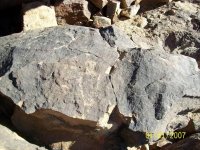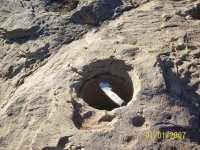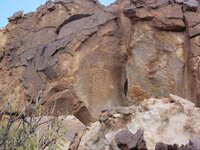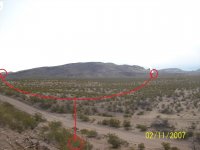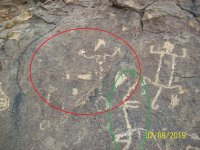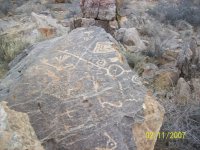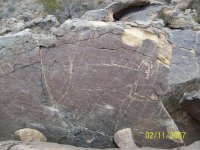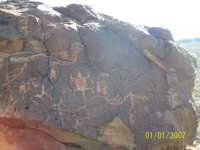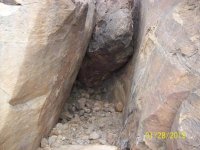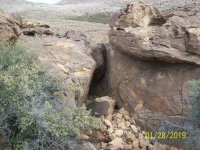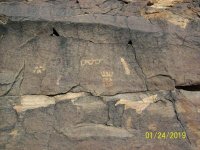whiskeyrat
Hero Member
Over the years I have found what seems to be the same treasure legend about Pedro Navarez, however, it seems to have 2 different versions that read almost the same except two different locations.
On story Posted below has the instruction to go 4 days north of Paso Del Norte and look for mountains on the left (west) with 2 large passes.
The other story has the instruction to go 2 days north of Paso Del Norte and look for mountains on the right (east) with 2 large passes.
Then both stories go on to give petty much the same directions about finding a spring, etc etc.
They have to be the same legend. But how are they so different on location, yet very much the same on directions after you arrive on the scene?
Pedro Navarez and the Caballo Mountains
Mexico City
Convent of St. Augustine
February 5, 1650
“Ask in Paso Del Norte where the Caballo Range is. You will find it four days by horse at a good pace up the river and not very far therefrom. Most of these mountains are of equal height and they have two large passes and a small amount of juniper trees. Coming along the King’s Highway (El Camino Real) from the pass, one will see on the left a range of mountains [this is after crossing the river at the pass and entering upon the first leg of the journey], to the right a flat plain (Jornada del Muerto) where the naked eye cannot circumscribe. There is a small hill a great distance from the road. [This is the point of the rocks] These marks you will find to your right where the point of the compass points to the sunrise. This range has two wide gaps which end in two arroyos, one running in the direction of the sunrise and the other toward sunset. The two have many ash trees, one having more than the other. In the gap where the sun rises, look for a small spring. The gap is not very big, a city could be built in the plain. The spring is not far from this gap, and it is well covered with juniper trees, stones, earth and large and small rocks on top. Look carefully at this spring, for it contains great riches. You can take out much gold beneath its surface. And from this spring count 250 varas toward the brow of the mountain, keeping to the level ground. Here you will find a stone with a very large cross chiseled upon its face. The stone is not of this region, having been brought in by mule train. From this point, count 100 varas and examine a small piece of ground closely. It has a few rocks so look carefully at its condition. Here you will find silver bars, there should be 18 atajas. Remove the boards under the bars and take 11 more atajas in finished silver. These marks are to the right before entering the gap, at the point of the compass where the sun rises. When you have finished this work, return to the spring in order that you may climb the mountain to your left. You will look for a very deep cave. There are 90 atajas of silver buried in this cave. I warn you to be careful and not to make a mistake for there are two other caves, but this one is the deepest of the three. The three are where the sun sets and I must tell you that there are some smaller caches and little springs, but all of them have been covered. And if any of these markings should be destroyed, then proceed with the utmost care in carrying out of the task. Return to the spring and climb the mountains to the right in the direction of the rising sun. Not very high up you will find a high rolling mesa, a placer, Here you can cut the copper with an axe and I believe that the spring comes from here. Other signs you will also find. In some places, painted figures with many writings engraved in copper. Therefore I urge you to search well for these marks. Thousands of families would be helped thereby.”
On story Posted below has the instruction to go 4 days north of Paso Del Norte and look for mountains on the left (west) with 2 large passes.
The other story has the instruction to go 2 days north of Paso Del Norte and look for mountains on the right (east) with 2 large passes.
Then both stories go on to give petty much the same directions about finding a spring, etc etc.
They have to be the same legend. But how are they so different on location, yet very much the same on directions after you arrive on the scene?
Pedro Navarez and the Caballo Mountains
Mexico City
Convent of St. Augustine
February 5, 1650
“Ask in Paso Del Norte where the Caballo Range is. You will find it four days by horse at a good pace up the river and not very far therefrom. Most of these mountains are of equal height and they have two large passes and a small amount of juniper trees. Coming along the King’s Highway (El Camino Real) from the pass, one will see on the left a range of mountains [this is after crossing the river at the pass and entering upon the first leg of the journey], to the right a flat plain (Jornada del Muerto) where the naked eye cannot circumscribe. There is a small hill a great distance from the road. [This is the point of the rocks] These marks you will find to your right where the point of the compass points to the sunrise. This range has two wide gaps which end in two arroyos, one running in the direction of the sunrise and the other toward sunset. The two have many ash trees, one having more than the other. In the gap where the sun rises, look for a small spring. The gap is not very big, a city could be built in the plain. The spring is not far from this gap, and it is well covered with juniper trees, stones, earth and large and small rocks on top. Look carefully at this spring, for it contains great riches. You can take out much gold beneath its surface. And from this spring count 250 varas toward the brow of the mountain, keeping to the level ground. Here you will find a stone with a very large cross chiseled upon its face. The stone is not of this region, having been brought in by mule train. From this point, count 100 varas and examine a small piece of ground closely. It has a few rocks so look carefully at its condition. Here you will find silver bars, there should be 18 atajas. Remove the boards under the bars and take 11 more atajas in finished silver. These marks are to the right before entering the gap, at the point of the compass where the sun rises. When you have finished this work, return to the spring in order that you may climb the mountain to your left. You will look for a very deep cave. There are 90 atajas of silver buried in this cave. I warn you to be careful and not to make a mistake for there are two other caves, but this one is the deepest of the three. The three are where the sun sets and I must tell you that there are some smaller caches and little springs, but all of them have been covered. And if any of these markings should be destroyed, then proceed with the utmost care in carrying out of the task. Return to the spring and climb the mountains to the right in the direction of the rising sun. Not very high up you will find a high rolling mesa, a placer, Here you can cut the copper with an axe and I believe that the spring comes from here. Other signs you will also find. In some places, painted figures with many writings engraved in copper. Therefore I urge you to search well for these marks. Thousands of families would be helped thereby.”


